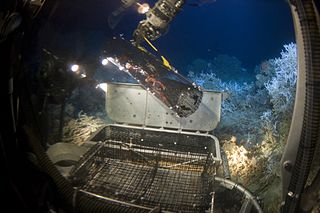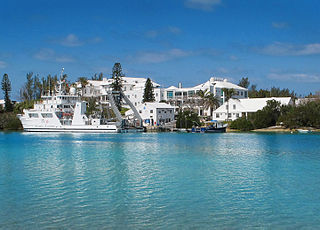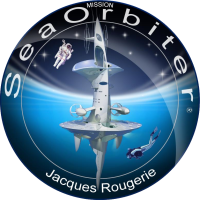
Trieste is a Swiss-designed, Italian-built deep-diving research bathyscaphe which reached a record depth of about 10,911 metres (35,797 ft) in the Challenger Deep of the Mariana Trench near Guam in the Pacific. On 23 January 1960, Jacques Piccard and US Navy Lieutenant Don Walsh achieved the goal of Project Nekton. It was the first manned vessel to reach the bottom of the Challenger Deep.

The Challenger Deep is the deepest known point in the Earth's seabed hydrosphere, with a depth of 10,902 to 10,929 m by direct measurement from deep-diving submersibles, remotely operated underwater vehicles, and benthic landers and (sometimes) slightly more by sonar bathymetry.

The Mariana Trench or Marianas Trench is located in the western Pacific Ocean about 200 kilometres (124 mi) east of the Mariana Islands; it is the deepest oceanic trench on Earth. It is crescent-shaped and measures about 2,550 km (1,580 mi) in length and 69 km (43 mi) in width. The maximum known depth is 10,984 metres (36,037 ft) at the southern end of a small slot-shaped valley in its floor known as the Challenger Deep. However, some unrepeated measurements place the deepest portion at 11,034 metres (36,201 ft). If Mount Everest were hypothetically placed into the trench at this point, its peak would still be underwater by more than two kilometres (1.2 mi).

Alvin (DSV-2) is a manned deep-ocean research submersible owned by the United States Navy and operated by the Woods Hole Oceanographic Institution (WHOI) in Woods Hole, Massachusetts. The vehicle was built by General Mills' Electronics Group in Minneapolis, Minnesota. Named to honor the prime mover and creative inspiration for the vehicle, Allyn Vine, Alvin was commissioned on 5 June 1964. The submersible is launched from the deep submergence support vessel RV Atlantis (AGOR-25), which is also owned by the U.S. Navy and operated by WHOI. The submersible has made more than 5,000 dives, carrying two scientists and a pilot, to observe the lifeforms that must cope with super-pressures and move about in total darkness, as well as exploring the wreck of Titanic. Research conducted by Alvin has been featured in nearly 2,000 scientific papers.

Rogue waves are unusually large, unpredictable and suddenly appearing surface waves that can be extremely dangerous to ships, even to large ones. They are distinct from tsunamis, which are caused by the displacement of water due to other phenomena and are often almost unnoticeable in deep waters. A rogue wave appearing at the shore is sometimes referred to as a sneaker wave.

A deep-submergence vehicle (DSV) is a deep-diving manned submarine that is self-propelled. Several navies operate vehicles that can be accurately described as DSVs. DSVs are commonly divided into two types: research DSVs, which are used for exploration and surveying, and DSRVs, which can be used for rescuing the crew of a sunken navy submarine, clandestine (espionage) missions, or both. DSRVs are equipped with docking chambers to allow personnel ingress and egress via a manhole.

Underwater habitats are underwater structures in which people can live for extended periods and carry out most of the basic human functions of a 24-hour day, such as working, resting, eating, attending to personal hygiene, and sleeping. In this context, 'habitat' is generally used in a narrow sense to mean the interior and immediate exterior of the structure and its fixtures, but not its surrounding marine environment. Most early underwater habitats lacked regenerative systems for air, water, food, electricity, and other resources. However, recently some new underwater habitats allow for these resources to be delivered using pipes, or generated within the habitat, rather than manually delivered.
The hadal zone, also known as the hadopelagic zone, is the deepest region of the ocean, lying within oceanic trenches. The hadal zone is found from a depth of around 6,000 to 11,000 metres, and exists in long but narrow topographic V-shaped depressions.

Aquarius is a launch vehicle concept designed for low-cost by Space Systems/Loral to carry small, inexpensive payloads into LEO.

NOAAS Ronald H. Brown is a blue-water research vessel of the U.S. National Oceanic and Atmospheric Administration, she is NOAA's only Global-Class research ship.

RV Knorr was a research vessel formerly owned by the U.S. Navy and operated by the Woods Hole Oceanographic Institution for the U.S. research community in coordination with and as a part of the University-National Oceanographic Laboratory System (UNOLS) fleet. On March 14, 2016, Knorr was officially transferred to the Mexican Navy and renamed Rio Tecolutla. She was replaced at Woods Hole by the RV Neil Armstrong. Knorr is best known as the ship that supported researchers as they discovered the wreck of the RMS Titanic in 1985. R/V Knorr (AGOR-15) has traveled more than a million miles—the rough equivalent of two round trips to the Moon or forty trips around the Earth. Her sister ship is the RV Melville.

R/V Thomas G. Thompson (AGOR-23) is a Global-class research vessel owned by the United States Office of Naval Research and operated under a bareboat charterparty agreement by the University of Washington as part of the University-National Oceanographic Laboratory System (UNOLS) fleet.

The Comandante Ferraz Antarctic Station is a permanent Antarctic research station named after the Brazilian Navy Commander Luís Antônio de Carvalho Ferraz (1940-1982), who visited Antarctica many times with the British exploration team and managed to convince his government to create a self-guided Brazilian Antarctic Program.

Aluminaut was the world's first aluminium submarine. An experimental vessel, the 80-ton, 15.5-metre (51 ft) manned deep-ocean research submersible was built by Reynolds Metals Company, which was seeking to promote the utility of aluminium. Aluminaut was based in Miami, Florida, and was operated from 1964 to 1970 by Reynolds Submarine Services, doing contract work for the U.S. Navy and other organizations, including marine biologist Jacques Cousteau.

Deep-sea exploration is the investigation of physical, chemical, and biological conditions on the sea bed, for scientific or commercial purposes. Deep-sea exploration is considered a relatively recent human activity compared to the other areas of geophysical research, as the depths of the sea have been investigated only during comparatively recent years. The ocean depths still remain a largely unexplored part of the planet, and form a relatively undiscovered domain.

Aurora Borealis is a proposed European research icebreaker, comparable to the world's strongest icebreakers, planned jointly by a consortium of fifteen participant organizations and companies from ten European nations. If built, she would be the largest icebreaker ever built as well as the first icebreaker built to the highest IACS ice class, Polar Class 1.

NOAAS Reuben Lasker is a National Oceanic and Atmospheric Administration (NOAA) fishery research vessel. The ship's namesake, Reuben Lasker, was a fisheries biologist who served with the Southwest Fisheries Center, National Marine Fisheries Service, and taught at the Scripps Institution of Oceanography. This class of NOAA ships is very similar to, and based in part upon, the Neil Armstrong-class Oceanographic Research (AGOR) ships owned by the Office of Naval Research and operated by various US Universities.

RV Atlantic Explorer is a twin-screw ocean vessel. It is owned and operated by the Bermuda Institute of Ocean Sciences (BIOS) in coordination with and as a part of the University-National Oceanographic Laboratory System (UNOLS) fleet. Atlantic Explorer is in compliance with US Coast Guard, UNOLS and American Bureau of Shipping (ABS) regulations as an uninspected oceanographic research vessel and is supported by the National Science Foundation (NSF). Its homeport is St. George's, Bermuda.

RV Kronprins Haakon is a Norwegian icebreaking polar research vessel owned by the Norwegian Polar Institute. The shiptime use is divided between the main users, the University of Tromsø, Norwegian Polar Institute and Norwegian Institute of Marine Research. She was built at Fincantieri shipyard in Genova, Italy, and delivered in 2018.

















